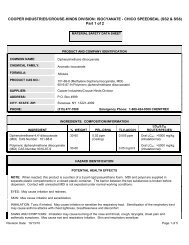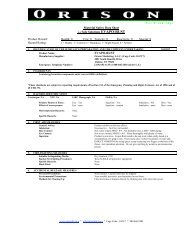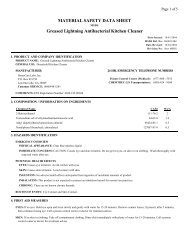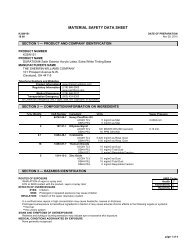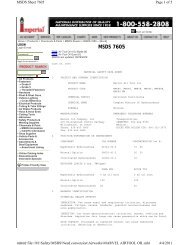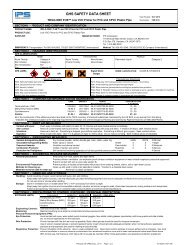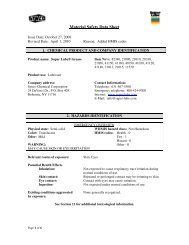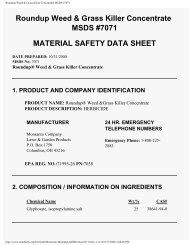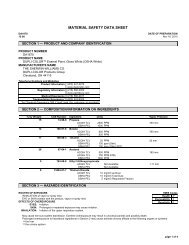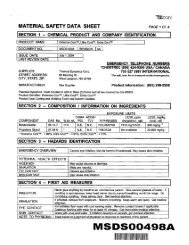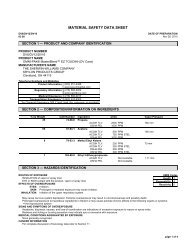wm barr klean-strip aircraft remover
wm barr klean-strip aircraft remover
wm barr klean-strip aircraft remover
Create successful ePaper yourself
Turn your PDF publications into a flip-book with our unique Google optimized e-Paper software.
MATERIAL SAFETY DATA SHEETKlean-Strip Aircraft RemoverPage:1Product Code:Product Name:Manufacturer InformationCompany Name:HEALTHFLAMMABILITYPHYSICAL HAZ.PPE211BFlammabilityHealth21Instability0Special1. Product and Company IdentificationQAR343Klean-Strip Aircraft RemoverW. M. Barr2105 Channel AvenueMemphis, TN 38113Phone Number: (901)775-0100Emergency Contact: 3E 24 Hour Emergency Contact (800)451-8346Information: W.M. Barr Customer Service (800)398-3892Web site address:www.<strong>wm</strong><strong>barr</strong>.comPreparer Name: W.M. Barr EHS Dept (901)775-01002. Composition/Information on IngredientsPrinted: 03/27/2008Revision: 09/04/2007Supercedes Revision: 02/16/2006Date Created: 04/19/2005Hazardous Components (Chemical Name)CAS # Concentration OSHA TWA ACGIH TWA Other Limits1. Dichloromethane {Methylene chloride} 75-09-2 60.0 -90.0 % 25 ppm 50 ppmNo data.2. Methanol {Methyl alcohol; Carbinol; Woodalcohol}67-56-1 2.0 -10.0 % 200 ppm 200 ppmNo data.3. Tall Oil Acostix NA 1.0 -5.0 % No data.No data.No data.4. Poly(oxy-1,2-ethanediyl),.alpha.-(nonylphenyl)-.omega.-hydr{Nonylphenol Ethoxylate}9016-45-9 1.0 -3.0 % No data.No data.No data.5. Polymer Mixture NA 1.0 -10.0 % No data.No data.No data.6. Ammonium hydroxide 1336-21-6 5.0 -15.0 % No data.No data.No data.7. Xylene (mixed isomers) {Benzene, dimethyl-} 1330-20-7 0.0 -10.0 % 100 ppm 100 ppmNo data.Hazardous Components (Chemical Name)CAS # OSHA STEL OSHA CEIL ACGIH STEL ACGIH CEIL1. Dichloromethane {Methylene chloride} 75-09-2 125 ppm (15 min) No data.No data.No data.2. Methanol {Methyl alcohol; Carbinol; Woodalcohol}67-56-1 No data.No data.250 ppmNo data.3.4.5.6.7.Tall Oil Acostix NA No data.Poly(oxy-1,2-ethanediyl),.alpha.-(nonylphenyl)-.omega.-hydr{Nonylphenol Ethoxylate}9016-45-9 No data.Polymer Mixture NA No data.Ammonium hydroxide 1336-21-6 No data.Xylene (mixed isomers) {Benzene, dimethyl-} 1330-20-7 No data.No data.No data.No data.No data.No data.3. Hazards IdentificationNo data.No data.No data.No data.150 ppmNo data.No data.No data.No data.No data.Emergency OverviewDanger! Poison. May be fatal or cause blindness if swallowed. Vapor harmful. Eye and skin irritant.OSHA Regulatory Status:This material is classified as hazardous under OSHA regulations.Potential Health Effects (Acute and Chronic)Inhalation Acute Exposure Effects:Vapor harmful. May cause dizziness; headache; watering of eyes; injuries to mucous membranes; irritation of thethroat and respiratory tract; nausea; numbness in fingers, arms and legs; bronchospasm; hot flashes; tissuedamage; spotted vision; dilation of pupils; increase of carboxyhemoglobin levels, which can cause stress to thecardiovascular system; arm, leg, and chest pains; depression of the central nervous system; bronchitis; pulmonaryLicensed to W.M. Barr and CompanyANSI Z400.1 Format
MATERIAL SAFETY DATA SHEETKlean-Strip Aircraft RemoverPage:Printed: 03/27/2008Revision: 09/04/2007Supercedes Revision: 02/16/2006edema; chemical pneumonitis; difficulty breathing; vomiting; visual disturbances; giddiness; intoxication;sleepiness; cough and dyspnea; cold, clammy, extremities, and diarrhea. Severe overexposure may causeirregular or rapid heartbeat; convulsions; unconsciousness; and death. Elevated carboxyhemoglobin levels can beadditive to the increase caused by smoking and other carbon monoxide sources.2Skin Contact Acute Exposure EffectsThis product is a skin irritant. May be absorbed through the skin. May cause irritation; burns; blisters; tissuedestruction; drying and defatting of skin; and dermatitis. May cause symptoms listed under inhalation. Vaporsand mist can irritate moist skin.Eye Contact Acute Exposure EffectsThis material is an eye irritant. May cause irritation and pain; conjunctivitis of eyes; corneal ulcerations of theeye; burns; and blindness. Vapors and mist can irritate eyes.Ingestion Acute Exposure EffectsPoison. Cannot be made non-poisonous. May be fatal or cause blindness. May cause irritation to mouth, throatand stomach; headache; nausea; dizziness; stupor; liver, kidney and heart damage; depression of the centralnervous system; narcosis; burning of esophagus, stomach, mouth and throat; vomiting; gastrointestinal irritation;diarrhea; abdominal pain; collapse; and death. May be corrosive to mouth and throat. May produce symptomslisted under inhalation. Liquid aspirated into lungs may cause chemical pneumonitis and systemic effects.Chronic Exposure EffectsReports have associated repeated and prolonged overexposure to solvents with neurological and otherphysiological damage. Prolonged or repeated contact may cause dermatitis. Prolonged skin contact may result inabsorption of a harmful amount of this material. May cause headache; conjunctivitis; gastric disturbances; skinirritation; permanent central nervous system changes; decreased response to visual and auditory stimulation;visual impairment or blindness; hallucinations; changes in blood; blood disorders; kidney, liver or pancreaticdamage; insomnia; giddiness; and death. May cause additional symptoms listed under inhalation.Signs and Symptoms Of ExposureSee Potential Health Effects.Medical Conditions Generally Aggravated By ExposureDiseases of the blood; skin; eyes; liver; kidneys; lungs; cardiovascular; pulmonary; and respiratory systems;alcoholism; and rhythm disorders of the heart.4. First Aid MeasuresEmergency and First Aid ProceduresInhalationIf user experiences breathing difficulty, move to air free of vapors. Administer oxygen or artificial respirationuntil medical assistance can be rendered.Skin ContactWash with soap and large quantities of water and seek medical attention if irritation from contact persists.Eye ContactFlush with large quantities of water for at least 15 minutes and seek immediate medical attention.IngestionCall your poison control center, hospital emergency room or physician immediately for instructions to inducevomiting.Licensed to W.M. Barr and CompanyANSI Z400.1 Format
MATERIAL SAFETY DATA SHEETKlean-Strip Aircraft RemoverPage:Printed: 03/27/2008Revision: 09/04/2007Supercedes Revision: 02/16/2006Note to PhysicianPoison. This product contains methanol and methylene chloride. Methanol is metabolized to formaldehyde andformic acid. These metabolites may cause metabolic acidosis, visual disturbances, and blindness. Sincemetabolism is required for these toxic symptoms, their onset may be delayed from 6 to 30 hours followingingestion. Ethanol competes for the same metabolic pathway and has been used as an antidote. Methanol iseffectively removed by hemodialysis. Adrenalin should never be given to a person overexposed to methylenechloride. Call your local poison control center for further information.5. Fire Fighting MeasuresFlash Pt:N.A.Explosive Limits: LEL: No data. UEL: No data.Fire Fighting InstructionsSelf-contained respiratory protection should be provided for fire fighters fighting fires in buildings or confinedareas. Storage containers exposed to fire should be kept cool with water spray to prevent pressure build-up. Stayaway from heads of containers that have been exposed to intense heat or flame.3Contact of liquid or vapor with flame or hot surfaces will produce toxic gases and a corrosive residue that willcause deterioration of metal.Flammable Properties and HazardsNo data available.Extinguishing MediaUse carbon dioxide, dry powder or foam.Unsuitable Extinguishing MediaNo data available.6. Accidental Release MeasuresSteps To Be Taken In Case Material Is Released Or SpilledClean-upKeep unnecessary people away; isolate hazard area and deny entry. Stay upwind, out of low areas, and ventilateclosed spaces before entering. Shut off ignition sources; keep flares, smoking or flames out of hazard area.Small SpillsTake up liquid with sand, earth or other noncombustible absorbent material and place in a plastic container whereapplicable.Large SpillsDike far ahead of spill for later disposal.Waste DisposalDispose in accordance with applicable local, state and federal regulations.7. Handling and StoragePrecautions To Be Taken in HandlingRead carefully all cautions and directions on product label before use. Since empty container retains residue,follow all label warnings even after container is empty. Dispose of empty container according to all regulations.Do not reuse this container.Licensed to W.M. Barr and CompanyANSI Z400.1 Format
MATERIAL SAFETY DATA SHEETKlean-Strip Aircraft RemoverPage:Printed: 03/27/2008Revision: 09/04/2007Supercedes Revision: 02/16/2006Precautions To Be Taken in StoringStore in a cool, dry place. Exposure to high temperatures or prolonged exposure to sun may cause can to leak orswell. Once opened, <strong>remover</strong> should be used within six months or discarded to avoid can deterioration. Do notstore near flames or at elevated temperatures.8. Exposure Controls/Personal ProtectionRespiratory Equipment (Specify Type)For OSHA controlled work place and other regular users. Use only with adequate ventilation under engineeredair control systems designed to prevent exceeding appropriate TLV. For occasional use, where engineered aircontrol is not feasible, use properly maintained and properly fitted NIOSH approved self-contained breathingapparatus for chlorinated solvent vapors. A dust mask does not provide protection against vapors.Eye ProtectionSafety glasses, chemical goggles or face shields are recommended to safeguard against potential eye contact,irritation, or injury. Contact lenses should not be worn while working with chemicals.Protective GlovesWear impermeable gloves. Gloves contaminated with product should be discarded. Promptly remove clothingthat becomes soiled with product.Other Protective ClothingVarious application mehods can dictate use of additional protective safety equipment, such as impermeableaprons, etc., to minimize exposure. A source of clean water should be available in the work area for flushing eyesand skin. Do not eat, drink, or smoke in the work area. Wash hands thoroughly after use. Before reuse,thoroughly clean any clothing or protective equipment that has been contaminated by prior use. Discard anyclothing or other protective equipment that cannot be decontaminated, such as gloves or shoes.Engineering Controls (Ventilation etc.)Use only with adequate ventilation to prevent build up of vapors. Open all windows and doors. Use only with across ventilation of moving fresh air across the work area. If strong odor is noticed or you experience slightdizziness, headache, nausea, or eye-watering, STOP ventilation is inadequate. Leave area immediately.9. Physical and Chemical PropertiesPhysical States: [ ] Gas [ X ] Liquid [ ] SolidMelting Point:No data.Boiling Point:No data.Autoignition Pt:No data.Flash Pt:N.A.Explosive Limits: LEL: No data. UEL: No data.Specific Gravity (Water = 1): 1.1683 - 1.1985Vapor Pressure (vs. Air or mm Hg): No data.Vapor Density (vs. Air = 1): No data.Evaporation Rate (vs Butyl No data.Acetate=1):Solubility in Water:No data.Percent Volatile:No data.VOC / Volume: 159.0000Corrosion Rate:No data.pH: 10 - 12Appearance and OdorNo data available.4Licensed to W.M. Barr and CompanyANSI Z400.1 Format
MATERIAL SAFETY DATA SHEETKlean-Strip Aircraft Remover10. Stability and ReactivityPage:Printed: 03/27/2008Revision: 09/04/2007Supercedes Revision: 02/16/2006Stability: Unstable [ ] Stable [ X ]Conditions To Avoid - InstabilityNo data available.Incompatibility - Materials To AvoidIncompatible with strong oxidizing agents; strong caustics; strong alkalis; oxygen; nitorgen peroxide; chemicallyactive metals such as aluminum and magnesium; sodium; potassium; and nitric acid.Hazardous Decomposition Or ByproductsThermal decomposition may produce hydrogen chloride; chlorine gas; small quantities of phosgene; carbonmonoxide; carbon dioxide; formaldehyde; and unidentified organic compounds in black smoke.Hazardous Polymerization: Will occur [ ] Will not occur [ X ]Conditions To Avoid - Hazardous PolymerizationWill not occur.No data available.Carcinogenicity/Other InformationNo data available.11. Toxicological InformationHazardous Components (Chemical Name)CAS # NTP IARC ACGIH OSHA1. Dichloromethane {Methylene chloride} 75-09-2 Possible2BA3Yes2. Methanol {Methyl alcohol; Carbinol; Woodalcohol}67-56-1 n.a.n.a.n.a.n.a.3.4.5.6.7.Tall Oil Acostix NA n.a.Poly(oxy-1,2-ethanediyl),.alpha.-(nonylphenyl)-.omega.-hydr{Nonylphenol Ethoxylate}9016-45-9 n.a.Polymer Mixture NA NoAmmonium hydroxide 1336-21-6 n.a.Xylene (mixed isomers) {Benzene, dimethyl-} 1330-20-7 n.a.No data available.n.a.n.a.Non.a.n.a.12. Ecological Information13. Disposal ConsiderationsWaste Disposal MethodDispose in accordance with applicable local, state, and federal regulations.LAND TRANSPORT (US DOT)DOT Proper Shipping Name14. Transport InformationFor Domestic Shipments:n.a.n.a.n.a.n.a.A4n.a.n.a.Non.a.n.a.5UN1760, Corrosive Liquid, N.O.S. 8, PGI (Ammonium Hydroxide, MethyleneChloride)DOT Hazard Class: 8DOT Hazard Label:CORROSIVEUN/NA Number: 1760Packing Group:IAdditional Transport InformationFor D.O.T. information, contact W.M. Barr Technical Services at 1-800-398-3892.Licensed to W.M. Barr and CompanyANSI Z400.1 Format
US EPA SARA Title IIIMATERIAL SAFETY DATA SHEETKlean-Strip Aircraft Remover15. Regulatory InformationPage:Printed: 03/27/2008Revision: 09/04/2007Supercedes Revision: 02/16/2006Hazardous Components (Chemical Name)CAS # Sec.302 (EHS) Sec.304 RQ Sec.313 (TRI) Sec.1101. Dichloromethane {Methylene chloride} 75-09-2 NoYes 1000 LB YesYes2. Methanol {Methyl alcohol; Carbinol; Woodalcohol}67-56-1 NoYes 5000 LB YesNo3.4.5.6.7.Tall Oil Acostix NA NoPoly(oxy-1,2-ethanediyl),.alpha.-(nonylphenyl)-.omega.-hydr{Nonylphenol Ethoxylate}9016-45-9 NoPolymer Mixture NA NoAmmonium hydroxide 1336-21-6 NoXylene (mixed isomers) {Benzene, dimethyl-} 1330-20-7 NoNoNoNoYes 1000 LBYes 100 LBSARA (Superfund Amendments andReauthorization Act of 1986) Lists:Sec.302: EPA SARA Title III Section 302 Extremely Hazardous Chemical with TPQ. * indicates 10000LB TPQ if not volatile.Sec.304: EPA SARA Title III Section 304: CERCLA Reportable + Sec.302 with Reportable Quantity. **indicates statutory RQ.Sec.313:EPA SARA Title III Section 313 Toxic Release Inventory. Note: -Cat indicates a member of achemical category.Sec.110:EPA SARA 110 Superfund Site Priority Contaminant ListEPA Hazard Categories:This material meets the EPA 'Hazard Categories' defined for SARA Title III Sections 311/312 as indicated:[X] Yes [ ] No Acute (immediate) Health Hazard[X] Yes [ ] No Chronic (delayed) Health Hazard[ ] Yes [X] No Fire Hazard[ ] Yes [X] No Sudden Release of Pressure Hazard[ ] Yes [X] No Reactive Hazard16. Other InformationThe information contained herein is presented in good faith and believed to be accurate as of the effective dateshown. This information is furnished without warranty of any kind. Employers should use this information onlyas a supplement to other information gathered by them and must make an independent determination of suitabilityand completeness of information from all sources to assure proper use of these materials and the safety and healthof employees. Any use of this data and information must be determined by the user to be in accordance withapplicable federal, state and local laws and regulations.Company Policy or DisclaimerThe information contained herein is presented in good faith and believed to be accurate as of the effective dateshown above. This information is furnished without warranty of any kind. Employers should use this informationonly as a supplement to other information gathered by them and must make independent determination ofsuitability and completeness of information from all sources to assure proper use of these materials and the safetyand health of employees. Any use of this data and information must be determined by the user to be inaccordance with applicable federal, state and local laws and regulations.NoNoNoNoYesNoNoNoNoYes6Licensed to W.M. Barr and CompanyANSI Z400.1 Format



